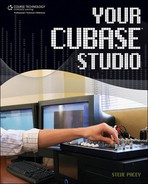The Video/Graphics Card and Monitors
Without a video card in your computer, you wouldn’t be able to see anything on your computer. I don’t think most computers will even work without some sort of video card installed. A video card offers several features. The most basic and important benefit is that you can plug an external monitor into it to see what you’re doing. Because working with Cubase requires working with many windows open at once, I highly recommend a video card that will support at least two monitors.
Note
Single- or dual-monitor setup? If time is valuable to you, spend a little extra and get a dual-monitor setup. If I could have a four-monitor setup, I would. The extra monitor helps save so more time when you’re in the studio.
Besides monitor outputs and hookups, the most important thing a video card does is help the processor display video on the screen. Did you know that every time anything changes in the display, the computer has to redraw the entire screen? You can probably guess, then, why video games require some serious graphics buffering. Cubase may not be quite up to par in looks with games such as Halo, but because Cubase is so audio-intensive, sometimes it has to steal resources from the video end of your computer. When this happens, you’ll see flickering on your screen, or it will freeze altogether. Once screens freeze, the rest of the system starts to freeze and you can lock up your whole system, forcing you to reboot and lose whatever it was you were working on. Even though advances in technology have made video cards much less of an audio concern, the balance between video and audio is still very important. If you don’t have a sufficient video card and the graphics are complex (maybe you’re monitoring video as you play back in Cubase), you may run into problems with your audio as well as your video. I remember the days when a video card that had 4 MB of VRAM was pretty cool. Now I see video cards with 768 MB of VRAM.
Note
VRAM is video random access memory. It’s a special type of memory chip developed strictly for video-card usage. This has nothing to do with your RAM (discussed later in this chapter).
With graphics becoming more and more important on computer systems, I predict that it won’t be long before video cards are graded by how many gigabytes of VRAM they offer. The more VRAM on your video card, the less of a load video will be on your CPU. There are several models of video cards on the market. Video cards and pro audio cards require a certain “chemistry” in order to work together. Unless you have the option of trying out the video card and running some tests on your system before you buy, I highly recommend that you visit your sound-card manufacturer’s Web site to see if there are any compatibility issues between your sound card and your video card. Assuming that your priorities for this computer revolve around your Cubase usage, your sound card is the more important choice. If you have to live with a slightly less desirable video card, so be it.
Another thing that’s becoming more of a consideration when buying computer systems is their ability to edit video. The system required for video editing is very similar to the system required for audio editing. The biggest difference is that video requires even more hard-drive space and a stronger video card than for audio editing. I don’t recommend putting consumer-grade video capture cards in your Cubase computer. If you must have video editing on your Cubase system, I highly recommend looking into some pro capture cards (those by such manufacturers as Blackmagic or Matrox) and checking with the manufacturers of both your sound card and your video card for compatibility issues. Once you have both cards together in a system, you should do some major testing before you jump into any serious Cubase projects. If you decide later on you want to add something like this to your system or change your video card, realize that this is not something you want to do when you’re in the middle of an important project. It takes finding a good balance, and upsetting that balance could lead to system failure.
When it comes to monitors and a Cubase system, there’s not a lot to discuss. Just find one that will be easy for you to look at for hours at a time. If you haven’t moved into the new millennium and upgraded to LCD flat-panel monitors, I highly recommend them. The flat panels not only take up less space in your studio, they also use less electricity and are easier to read for long hours. They’re also much less susceptible to video “burn in,” which happens when an image remains on the screen for long hours at a time. The bigger the monitor is, the better it is for working with Cubase. But if you’re debating whether you want to get one really big monitor or two smaller monitors, get the two smaller monitors. Cubase works best with multiple monitors, hands down.
